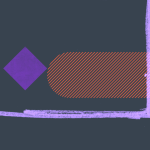For roads, bridges, buildings, and numerous other structures, concrete provides a sturdy and long-lasting basis. It is the cornerstone of many construction projects. Although a well-poured and leveled concrete surface may appear simple in the end, achieving it requires a precise and complex process.
We will walk you through the entire concrete pouring and leveling process in this in-depth tutorial, highlighting the need of hiring a reputable concrete company to ensure the success of these vital building projects.
Step 1: Arranging and Getting Ready
- Planning: Careful planning is necessary before any concrete is poured. This includes figuring out the specifications for the project, like the kind of concrete that will be used, how thick it must be, and whether any reinforcements are required.
- Site Preparation: Excavation, grading, and making sure the subgrade is compacted and stable are some of the tasks that go into properly preparing a construction site.
- Formwork: To specify the proportions and shape of the concrete building, formwork, which is frequently composed of steel, aluminum, or wood, is built. During the pouring process, formwork is also used to contain the wet concrete.
Step 2: Blending and Transferring
- Mix for Concrete: The right concrete mix is essential and is determined by the project’s requirements. Typically, the mixture is made up of cement, water, additives, and aggregates like sand and gravel. To acquire the desired qualities, the components are measured and combined with great care.
- Transportation: The concrete is brought to the construction site after it has been mixed. Ready-mix concrete trucks can be used for this, guaranteeing that the concrete will be of a constant quality during its journey from the batching facility to the job site.
Step 3: Pouring the Concrete
- Placement: The formwork is filled with concrete that is poured from the delivery truck. To prevent segregation, or the separation of the cement paste from the aggregates, the concrete must be applied evenly.
- Consolidation: To guarantee a dense, uniform mixture and eliminate air spaces, the concrete is compacted after placing. Concrete can be manually stirred or it can be done with vibration equipment.
- Finishing: To get the appropriate texture and look, finishing entails polishing the concrete’s surface. Typically, a variety of tools are used, including as floats, trowels, and screeds.
Step 4: Remedying
- Curing: The process of allowing concrete to reach the appropriate strength and durability involves keeping it at the right temperature, moisture content, and time. This may entail applying wet blankets to the concrete or using curing agents or wet curing.
Step 5: Screeding and Leveling
- Cracking: Creating a smooth and level concrete surface requires leveling and screeding. A screed is used to remove extra concrete and raise the surface to the required height. It can be as simple as a straight board or as powerful as a mechanical tool.
- Strike-Off: This technique entails sliding the screed across the concrete’s surface, eliminating extra material, and leaving a level, smooth surface behind.
- Verify for Levelness: During this stage, exact measurements and level inspections are performed to guarantee that the concrete surface is consistent and meets the project’s requirements.
Step 6: Floating Bulls
- Bull Floating: The concrete surface is further smoothed and leveled with a bull float following screeding. It is a big, flat instrument that is used to push and drag across concrete to remove high places and fill in low spots.
Step 7: Jointing and Edging
- Edging: Round, smooth margins are created around the concrete’s edge using edging tools. This improves the look and lessens the likelihood of chipping and cracking.
- Jointing: To prevent cracking, concrete is designed with control joints, sometimes referred to as contraction joints. These connections, which are usually carved into the surface at regular intervals, aid in releasing tension brought on by temperature variations and shrinkage.
Step 8: Concluding Details
- Final Finishing: To give the concrete the proper texture and look, the last finishing touches are placed. For decorative concrete, this might involve a variety of methods such swirl finishing, broom finishing, or stamping.
Step 9: Healing and Defense
- Curing: Following the pouring and finishing of the concrete, more curing takes place. In order to achieve the desired strength and durability of the concrete, proper curing is essential. To keep moisture levels stable, curing chemicals, wet curing, or other techniques are employed.
- Protection: During the curing process, the freshly poured and finished concrete needs to be shielded from weather, traffic, and other potential sources of harm. This may entail the use of temporary fencing, plastic sheeting, or curing blankets.
Step 10: Inspection and Quality Control
- Quality Control: To make sure the concrete satisfies the project’s requirements, quality control procedures are followed throughout the whole process. Testing for slump, compressive strength, and other characteristics is part of this.
- Inspection: To ensure that the work is being completed in accordance with local building codes and industry standards, inspectors may pay a visit to the site.
The Value of Expert Services from Concrete Companies
While it’s helpful to know the procedures for pouring and leveling concrete, accuracy, skill, and experience are necessary for these jobs to be completed successfully. In order to guarantee that your concrete projects are finished to the highest standards of quality and conformity to industry norms, concrete companies Charleston services are essential. The following are some justifications for why expert aid is essential:
- Expertise: Experienced concrete contractors are equipped with the know-how to organize, carry out, and finish concrete pouring and leveling jobs to the highest standards.
- High-quality Materials: Are available to professionals, guaranteeing that the final product satisfies durability and performance standards. These materials include reinforcing steel and concrete.
- Appropriate Tools: Concrete contractors are equipped with the right tools and equipment, such as screeds, floats, mixers, and finishing equipment, for the project.
- Compliance: Skilled concrete contractors are knowledgeable about the building laws and regulations in your area, so they can make sure your project conforms with all applicable permits and safety standards.
- Efficiency: Experts can minimize delays and disturbances by working quickly and accurately to finish tasks on time.
- Safety: Is the top priority in the construction industry. In order to reduce dangers on the construction site, skilled concrete contractors put the safety of their employees, the general public, and the environment first.
- Long-Term Warranty: You can feel secure knowing that your investment is safeguarded because a lot of reputable concrete businesses give warranties for their work.
In summary, there are several complex procedures involved in the pouring and leveling of concrete that need for skill and accuracy. Although it can appear simple, creating a level and smooth concrete surface is a skilled trade best left to experts. You can guarantee that your concrete projects are finished with the highest level of quality, durability, and adherence to industry standards by hiring skilled concrete contractors. This will result in surfaces that are not only long-lasting and aesthetically pleasing but also functional, find more here.


